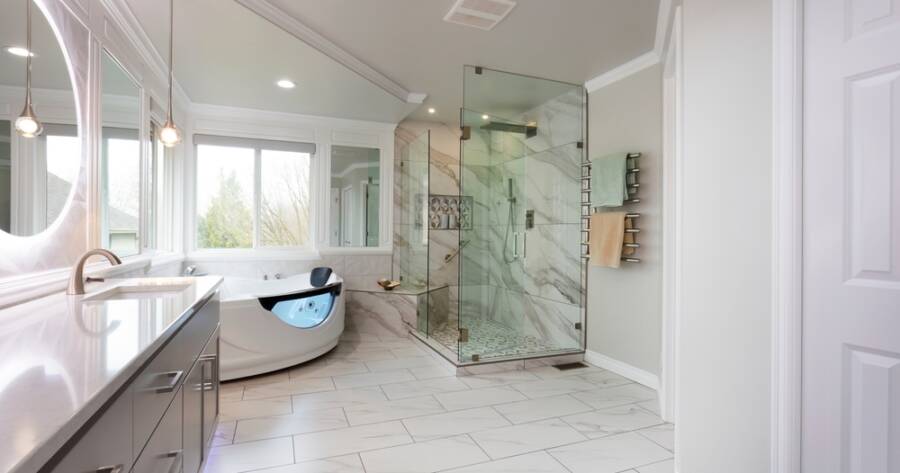Aging in place is an increasingly popular option for seniors who wish to maintain their independence and stay in their homes as they grow older. The bathroom, often considered the most hazardous room in the house, requires thoughtful remodeling to ensure safety, accessibility, and comfort. Planning these modifications carefully can help you create a functional, future-proof space that meets evolving needs. Discover the essential components of an aging-in-place bathroom remodel.
Key Features of Aging-in-Place Bathroom Remodels
The primary focus of an aging-in-place bathroom remodel is to reduce safety risks and enhance accessibility. Essential features include walk-in showers, grab bars, non-slip flooring, wider doorways, raised fixtures, and improved lighting. These modifications are not just functional but can also add value to your home.
The total cost typically ranges from $3,000 to $15,000, depending on the extent of modifications and quality of materials. By planning and prioritizing key features, you can create a functional and stylish bathroom that allows you or your loved ones to age with dignity and independence.
1. Walk-In Showers and Bathtubs
Traditional bathtubs can pose a significant fall risk for seniors due to the high threshold. Walk-in showers or bathtubs eliminate this issue by providing easy entry and exit. Features like built-in seating, adjustable showerheads, and grab bars inside the shower enhance safety and usability. Low or zero-entry thresholds are particularly important for individuals with mobility challenges, including wheelchair users.
2. Grab Bars and Safety Railings
Grab bars are essential additions to ensure stability in key areas of the bathroom, such as near the shower, toilet, and sink. Modern designs allow grab bars to double as towel racks or integrate seamlessly into the room’s aesthetic. These sturdy fixtures provide peace of mind and prevent potentially life-threatening falls.
3. Non-Slip Flooring
Slippery floors are one of the leading causes of bathroom accidents. Non-slip flooring materials, such as textured vinyl, rubber, or non-slip ceramic tiles, provide a safer surface for walking. These materials are also easy to clean and maintain, making them a practical choice for aging homeowners.
4. Wider Doorways and Accessible Layouts
Wider doorways accommodate wheelchairs and walkers, ensuring easy entry and exit. Standard doorways may need to be widened to meet accessibility standards. Lever-style door handles are easier to operate than traditional round knobs, especially for those with limited hand strength. Additionally, a well-thought-out layout ensures there’s enough space to maneuver safely.
5. Raised Toilets
Standard toilets can be challenging to use for individuals with mobility issues. Raised or comfort-height toilets are designed to make sitting and standing more comfortable. Wall-mounted or adjustable-height models offer additional flexibility and ergonomic benefits.
6. Adjustable Fixtures and Sinks
Accessible fixtures like lever-handled faucets and adjustable-height sinks cater to users with varying mobility levels. These features are particularly beneficial for individuals who use wheelchairs, as they provide better reach and usability.
7. Lighting Upgrades
Good lighting is critical for visibility and safety in the bathroom. Motion-sensor lights, anti-glare fixtures, and under-cabinet lighting are practical additions. These upgrades improve visibility while creating a welcoming and well-lit environment.
Additional Considerations
- Labor and Permits: Professional installation ensures safety and compliance with local building codes. Depending on the scope of your remodel, permits may be required.
- ADA Guidelines: Incorporating design elements based on ADA (Americans with Disabilities Act) standards ensures accessibility and usability for everyone.
- Future-Proofing: Consider modular features or designs that can adapt to future needs, such as removable shower seats or adjustable fixtures.
Benefits of Aging-in-Place Bathroom Remodels
A thoughtfully remodeled bathroom improves safety, enhances independence, and reduces the risk of injuries. It also provides peace of mind for family members concerned about the well-being of their aging loved ones. Additionally, these modifications can increase the home’s resale value, appealing to buyers looking for accessible features.
Learn More Today
Remodeling your bathroom for aging in place is an investment in safety, comfort, and long-term independence. By prioritizing essential features and working with professionals, you can create a functional, stylish bathroom that supports your needs now and in the future. Proper planning ensures that your home remains a safe and comfortable haven as you age gracefully.

